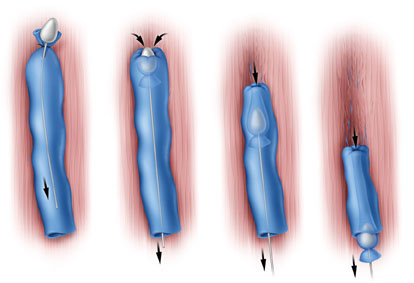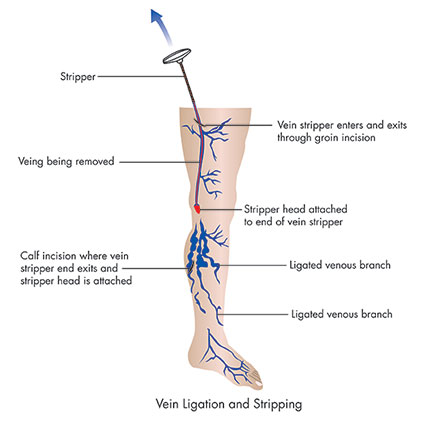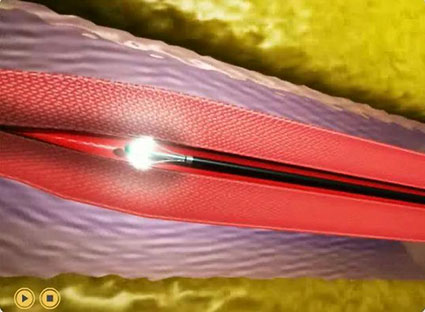
Endovenous Laser Ablation (EVLA)
EVLA Endovenous Laser Ablation is a revolutionary treatment to permanently and immediately resolve protruding, aching or painful varicose veins cause by incompetence of the deep vein system. Older techniques to address this include surgical ligation and stripping. EVLA was approved by the FDA in 2002 and by Health Canada in 2003.
EVLA boasts a success rate of 93% with a recurrence rate of only 7% two years following the procedure. Most patients require either no pain medication at all or simply over-the-counter options to treat the minor discomfort after undergoing the EVLA procedure. Patients return to normal activities almost immediately after this procedure.
Despite not being funded by OHIP, EVLA has become an increasingly popular choice for those suffering with significant, symptomatic varicose veins. In addition to being less invasive than stripping or surgical ligation, patients are able to return to their normal activities much more quickly than after those older procedures. The effectiveness, safety, and minimal downtime offered by the EVLA procedure makes this the preferred choice of treatment when incompetency of the deep vein system has been identified.

The Procedure
Local anaesthetics are used to freeze the area where the needle will penetrate. A needle is inserted into the vein, followed by a laser probe whose position is established by ultrasound. Once it is has been determined that the probe is in the correct area, it is slowly heated with low energy. The applied energy causes the vein walls to shrink, preventing the flow of blood by eventually closing the vein. After the closing of the vein is complete, the laser probe is removed and a compression bandage is applied.
What to Expect – Before EVLA™
You will have an initial consultation and diagnostic testing. During the consultation, a physical examination and Doppler assessment (diagnostic test) will be performed. Photographs will also be taken of your leg veins.
Diagnostic testing will help determine the source of your venous problem: the in-office Doppler will allow us to hear the direction of blood flow in your veins. If the exam reveals saphenous vein incompetence (a back flow of blood in the vein) then further diagnostic testing, including colour ultrasound imaging may be performed.
What to Expect – During EVLA™
Under ultrasound guidance and local anaesthesia, a catheter (hollow tube of extremely narrow diameter) is inserted into the vein and a laser fiber is passed through the catheter. The fiber and catheter are slowly withdrawn while laser energy is released along the vein to seal it completely.
What to Expect – After EVLA™
No stitches are necessary. You will take an anti-inflammatory medication for 8 days. The treated area will be covered with a compression pad and a thigh-high support stocking will be placed on your leg. The compression pad can be removed after 2 days. The support stocking should be worn for one week minimum. You may resume light daily activities the next day (no strenuous exercise or prolonged standing). At 24 hours and 4 to 7 days following the procedure, most patients will experience moderate bruising and some lumpiness and soreness in the treated area. Pain can be minimal to moderate. All local side effects generally disappear within 1 to 2 weeks. To confirm successful treatment, a Doppler and Color Duplex Ultrasound will be performed at 1 week and various monthly intervals after the procedure. Most patients will need sclerotherapy for remaining superficial varicosities and spider veins.
Notable Benefits
- Immediate relief from symptoms
- No scarring
- Only a local anaesthetic is needed
- Can be performed in the doctor’s office (no hospitalization needed)
- Treatment in less than an hour
- Normal activities can be resumed immediately – with little or no pain

Pre-Treatment Instructions
Refrain from taking Aspirin, Ibuprofen, or arthritis medications for at least one week prior to your treatment. These medications can increase your risk of bruising
Do not drink alcoholic beverages or smoke for 2 days both before and after your treatment as this may hinder the healing process
The morning of your appointment, shower and wash your legs with an antibacterial soap. Do not shave your legs the day of your appointment
Avoid applying cream or lotion to your legs the day of your appointment (including tanning creams and sprays)
For your own comfort, it is recommended that you bring loose fitting shorts to wear during your treatment
Try to eat a light meal approximately an hour prior to treatment
If you tend to get lightheaded during medical procedures, you may want to consider having someone drive you home after your appointment
Bring your compression stockings with you to your appointment.
Post Treatment Instructions
Immediately post treatment, go for a 30 minute walk to stimulate your circulation.
Elevate your legs above your heart for a period of approximately 4 hours. During this 4 hour period, every 45 minutes ensure that you get up and walk for 15 minutes.
Following the period of leg elevation, daily exercise your legs for 30 minutes (e.g. a brisk walk or mild cycling) for 7 days post treatment.
A compression stocking and bandage will be placed over the area to provide compression, collapsing the vein network. This is to be worn continuously for 2 days and 2 nights following your treatment. You may then take it off at bedtime for the next 5 days. Continue to wear for a total of one week. It is beneficial to continue wearing the compression stockings for six weeks in order to optimize your results. Remove the stocking if you are experiencing numbness, tingling, cramping, or pain in your foot or calf.
Keep your bandage dry. If you wish to shower in the first two days, you must leave the bandage and a thigh-high support stocking on your treated leg. The leg should be covered with a plastic garbage bag sealed with a towel wrapped around the top of the leg to keep it dry.
Normal activity can be resumed during this period, but hot baths and hot tubs and vigorous activity, such as gym workouts, weightlifting, and jogging should be avoided for 2 weeks. Exercise routines can be gradually resumed according to how your leg feels.
Any leg discomfort should respond to leg elevation, leg exercise, or Ibuprofen (Advil). We recommend taking Ibuprofen regularly after your treatment: 400 to 600 mg (2 to 3 tablets) taken 3 times per day (avoid if you are allergic or have stomach ulcers). You may supplement this safely with full doses of acetaminophen every 4 hours if necessary.
Some discomfort is common, particularly between days 3 to 7 along the site of the treated vein.
The most common complication is an inflammation of the vein. It may appear anytime in the first month post treatment and consists of a hard, tender cord along the vein. The discomfort is usually minor and is relieved by the application of ice and the use of support stockings (apply ice for 15 minutes, four times a day).
Do not drive or operate hazardous equipment until the next day due to the effects of Ativan.
No long automobile or plane trips for four weeks.
Expected Recovery
Time spent recovering from treatments tends to be very short. As there are no incisions with EVLA, there is no post procedural scarring. Bruising and mild swelling may occur but discomfort can be kept to a minimum with over the counter pain medications. You will be encouraged to take a short walk (approximately 30 minutes) directly following treatment.
Possible Complications
Complications associated with EVLA are rare. Some patients note a mild numbness or pulling sensation for approximately a week following the procedure. Very rarely will a patient experience a deep venous thrombosiswhich is the formation of a blood clot deep within the treated vein.
Frequently Asked Questions
How does EVLT work?
The applied energy causes the vein walls to shrink, preventing the flow of blood by eventually closing the vein.

There is no danger to closing off the compromised vein. The blood will be diverted to normal veins in order to continue its path to the heart. The backward flow of blood in varicose veins and main superficial trunks, the greater saphenous (GSV), and lesser saphenous (LSV) vein interfere with the normal venous return of blood. Circulation actually improves with the closure of the faulty vein. This marked improvement in circulation subsequently improves circulation in the entire treated limb, relieving symptoms of tiredness and heaviness in the limb.
Am I at risk from the laser?
You will not be at risk from the laser. You will be provided with a special pair of glasses to wear as a precautionary measure.
How long will the treatment take?
Treatment will normally take anywhere from 45 to 90 minutes.
Will I be in pain after my treatment?
Patients report that there is no pain during the procedure. Occasionally, they do experience a feeling of heat, with brief discomfort, from the laser energy. Mild discomfort is common following treatment. There may also be some tenderness in the treated area for 1 to 2 weeks following. You may use over-the-counter medications, such as Ibuprofen regularly to relieve any symptoms.
How long will I be off my feet?
Recovery is minimal. Patients can walk out of the office after the procedure and, in most cases, quickly resume normal activities, excluding strenuous exercise and prolonged standing. Long car rides or plane trips should be avoided for 3 to 4 weeks.
What are the typical side effects of EVLA?
The side effects are bruising and sometimes a sore, lumpy cord in the treated area, both of which disappear within 1 to 2 weeks of the procedure.
Will I be able to drive home?
You will be given a medication to help you relax during the procedure so you will need someone to drive you home.
What is the alternative to this treatment?
Traditionally, faulty saphenous veins have been treated with ligation and surgical stripping. This procedure is performed under general anaesthesia and involves incisions in order to tie off and remove the faulty vein. EVLA is a minimally invasive, in-office procedure. It requires only local anaesthesia and no stitches. Patients can walk out of the office and quickly return to normal activities.
Are there alternative minimally invasive treatments available?
Sudbury Vein Clinic offers sclerotherapy (injection therapy). Sclerotherapy for the saphenous vein appears to have a high recurrence rate, frequently requiring retreatment. It is, however, an excellent option for the treatment of any visible veins remaining after EVLA.
How successful is EVLA?
EVLT’s success rate is 93% two years following the procedure. EVLA will normally treat the cause of most vein reflux disease but additional or complimentary treatment such as sclerotherapy and echosclerotherapy may be necessary.
